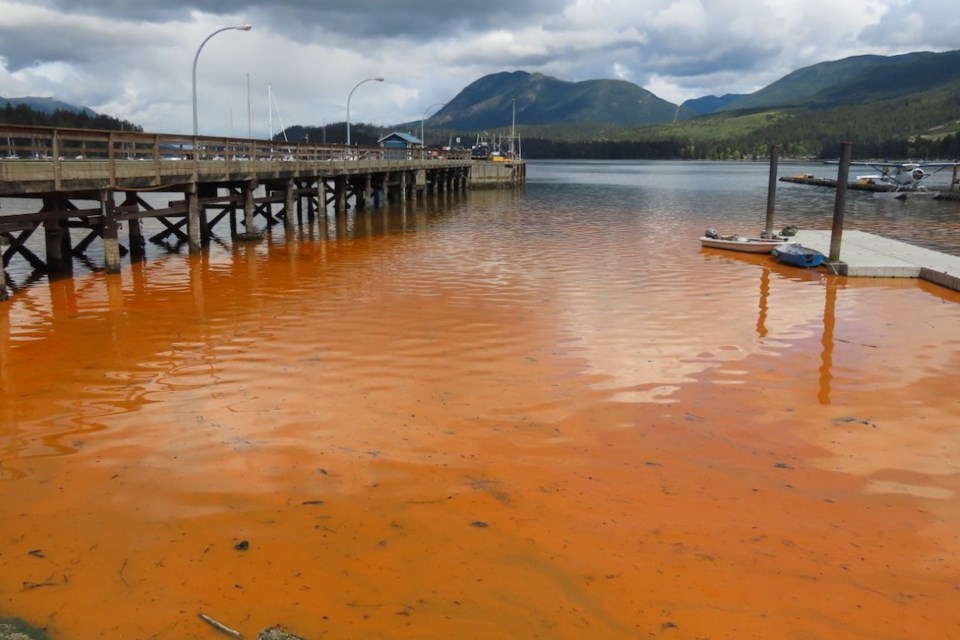Sections of the usually blue-green waters of Sechelt’s Porpoise Bay became a bright shade of orange on May 7 and 8. While eye-catching, the temporary change is typically seen in B.C. waters at this time of year.
What is 'red tide'?
It’s not red, or even a tide. It’s an algae bloom — but it’s also not really algae.
Andrea Locke, a research scientist with Fisheries and Oceans Canada (DFO) at the Institute of Ocean Sciences, is “99 per cent certain” it’s Noctiluca scintillans, a single-cell organism. Or rather, many of them. (To be 100 per cent sure, Locke would need to examine a sample underneath a microscope.) Photographs show the tell-tale characteristics of the natural phenomenon and it’s the right time of year.
Much of Locke’s work is with harmful algal blooms. Although, she points out, Noctiluca scintillans isn’t actually algae, even though it’s classified and “lumped together” as such. Most algae photosynthesize, but Noctiluca scintillans feeds on algae, fish eggs, bacteria — life forms smaller than itself.
“They're very common at this time of year, they tend to show up in May,” Locke said. “Right after you get the kind of spring bloom starting of all the other algae that really are photosynthetic, these guys show up shortly afterwards.”
Even though it’s also classified as harmful algae, Noctiluca scintillans is not the type that causes shellfish toxins, and there’s no need for a shellfish closure. The harmful classification comes from the creature’s ability to create concentrations of ammonia in the water as a byproduct of its metabolism. Even then, it’s rare to see fish or vertebrate mortalities as a result and it’s being diluted by surrounding water, Locke said. Any type of algal bloom can potentially deplete oxygen levels in the water, she added, because of the “boom and bust” cycle of blooms. They appear near the surface, then typically die off and their decomposition uses up oxygen in the water.
“It's a fairly subtle effect,” Locke said. “It's probably not going to cause massive die-offs or anything like that.”
The marine species of dinoflagellate can exist in a green or red form, depending on what part of the world they exist in. They’re more green closer to the equator, Locke says.
Local reports
On Sunday, May 8, Leonard Stott and his wife came upon the bloom during their usual stroll at the docks, near Lighthouse Pub and where the seaplanes take off, when Stott said, "Would you look at that colour!" It covered the area from the end of the pier to the shoreline, he said.
"I've never seen anything like it," Stott told Coast Reporter, and started snapping photos.
The first reports Locke heard about the latest so-called red tide appearing on the Sunshine Coast came from her brother and sister-in-law, who are travelling along the coast by boat. As they went from Sydney to Princess Louisa Inlet, they sent photos of the orange patches.
“I'm surprised we haven't actually seen it a little earlier,” Locke said. “I think because we've had a fairly cool and late spring, we're seeing it a little late.”
The orange blooms will likely be seen for the next few weeks before it clears up. Indeed, when Stott returned the next day, "It was as clear as a bell. None of that horrible red colour was there."
AKA sea sparkles
Noctiluca scintillans is also known as “sea sparkles” and is the responsible creature for the blue bioluminescence occurring off B.C.’s coast, typically in late summer.
Coastal Server spotted
On the same Sunday, a new vessel was also spotted on Sechelt Inlet. The Coastal Server spent some time near Poise Island in Porpoise Bay before heading closer to Salmon Inlet on May 9. The 24-metre vessel, which was built in 2021, is contracted by Greig Seafoods BC Ltd. and was in the area to complete scheduled pro-active sea lice treatments for the company’s farmed salmon, communications director Amy Jonsson told Coast Reporter via email. The vessel uses a mechanical delousing system called SkaMik 1.5. The team had to travel around the inlet to find adequate reception for some phone calls, she added.
“The team wasn’t aware of any harmful algae reports for the area, and the regular water sampling at the farms didn’t show any elevated levels,” Jonsson wrote.
Algae research
In 2021, the Ministry of Environment and Climate Change started a citizen science project called Algae Watch to gather information for research and to help scientists and the public understand cyanobacteria and algae blooms. Since the Algae Watch observation map launched, there have been no submissions from the public for the Sunshine Coast area. That could be because the project’s scope focuses on fresh water, rather than saltwater blooms.
Locke said the Pacific Salmon Foundation also has a citizen science program that looks at harmful algae, among other things. Updates on blooms can be found on their social media.
The First Nations Health Authority recently launched a pilot project called We All Take Care of the Harvest (WATCH) that “addresses seafood safety, security and sovereignty in the context of climate change,” according to the FNHA website. “The purpose of the project is to help coastal communities and their members decide if and when their seafood is safe to harvest.”
For those on the Coast who see the “red tide” or other interesting algal observations, Locke said they can email her at [email protected] to share photos and observations, as researchers don’t always have real-time data.



